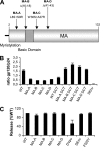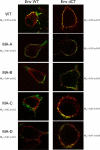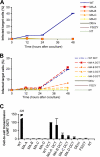HIV cell-to-cell transmission requires the production of infectious virus particles and does not proceed through env-mediated fusion pores
- PMID: 22258237
- PMCID: PMC3302491
- DOI: 10.1128/JVI.06478-11
HIV cell-to-cell transmission requires the production of infectious virus particles and does not proceed through env-mediated fusion pores
Abstract
Direct cell-to-cell transmission of human immunodeficiency virus (HIV) is a more potent and efficient means of virus propagation than infection by cell-free virus particles. The aim of this study was to determine whether cell-to-cell transmission requires the assembly of enveloped virus particles or whether nucleic acids with replication potential could translocate directly from donor to target cells through envelope glycoprotein (Env)-induced fusion pores. To this end, we characterized the transmission properties of viruses carrying mutations in the matrix protein (MA) that affect the incorporation of Env into virus particles but do not interfere with Env-mediated cell-cell fusion. By use of cell-free virus, the infectivity of MA mutant viruses was below the detection threshold both in single-cycle and in multiple-cycle assays. Truncation of the cytoplasmic tail (CT) of Env restored the incorporation of Env into MA mutant viruses and rescued their cell-free infectivity to different extents. In cell-to-cell transmission assays, MA mutations prevented HIV transmission from donor to target cells, despite efficient Env-dependent membrane fusion. HIV transmission was blocked at the level of virus core translocation into the cytosol of target cells. As in cell-free assays, rescue of Env incorporation by truncation of the Env CT restored the virus core translocation and cell-to-cell infectivity of MA mutant viruses. These data show that HIV cell-to-cell transmission requires the assembly of enveloped virus particles. The increased efficiency of this infection route may thus be attributed to the high local concentrations of virus particles at sites of cellular contacts rather than to a qualitatively different transmission process.
Figures







Similar articles
-
HIV-1 Matrix Trimerization-Impaired Mutants Are Rescued by Matrix Substitutions That Enhance Envelope Glycoprotein Incorporation.J Virol. 2019 Dec 12;94(1):e01526-19. doi: 10.1128/JVI.01526-19. Print 2019 Dec 12. J Virol. 2019. PMID: 31619553 Free PMC article.
-
A monomeric envelope glycoprotein cytoplasmic tail is sufficient for HIV-1 Gag lattice trapping and incorporation.J Virol. 2025 May 20;99(5):e0210524. doi: 10.1128/jvi.02105-24. Epub 2025 Apr 15. J Virol. 2025. PMID: 40231821 Free PMC article.
-
Trimer Enhancement Mutation Effects on HIV-1 Matrix Protein Binding Activities.J Virol. 2016 May 27;90(12):5657-5664. doi: 10.1128/JVI.00509-16. Print 2016 Jun 15. J Virol. 2016. PMID: 27030269 Free PMC article.
-
The role of matrix in HIV-1 envelope glycoprotein incorporation.Trends Microbiol. 2014 Jul;22(7):372-8. doi: 10.1016/j.tim.2014.04.012. Epub 2014 Jun 2. Trends Microbiol. 2014. PMID: 24933691 Free PMC article. Review.
-
The Interplay between HIV-1 Gag Binding to the Plasma Membrane and Env Incorporation.Viruses. 2020 May 16;12(5):548. doi: 10.3390/v12050548. Viruses. 2020. PMID: 32429351 Free PMC article. Review.
Cited by
-
Capacity of Broadly Neutralizing Antibodies to Inhibit HIV-1 Cell-Cell Transmission Is Strain- and Epitope-Dependent.PLoS Pathog. 2015 Jul 9;11(7):e1004966. doi: 10.1371/journal.ppat.1004966. eCollection 2015 Jul. PLoS Pathog. 2015. PMID: 26158270 Free PMC article.
-
Cell-cell transmission of VSV-G pseudotyped lentivector particles.PLoS One. 2013 Sep 10;8(9):e74925. doi: 10.1371/journal.pone.0074925. eCollection 2013. PLoS One. 2013. PMID: 24040363 Free PMC article.
-
Quantifying the Antiviral Effect of IFN on HIV-1 Replication in Cell Culture.Sci Rep. 2015 Jun 29;5:11761. doi: 10.1038/srep11761. Sci Rep. 2015. PMID: 26119462 Free PMC article.
-
HIV cell-to-cell transmission: effects on pathogenesis and antiretroviral therapy.Trends Microbiol. 2015 May;23(5):289-95. doi: 10.1016/j.tim.2015.02.003. Epub 2015 Mar 9. Trends Microbiol. 2015. PMID: 25766144 Free PMC article. Review.
-
CIB1 and CIB2 are HIV-1 helper factors involved in viral entry.Sci Rep. 2016 Aug 4;6:30927. doi: 10.1038/srep30927. Sci Rep. 2016. PMID: 27489023 Free PMC article.
References
Publication types
MeSH terms
Substances
LinkOut - more resources
Full Text Sources
Other Literature Sources
Medical
Research Materials

